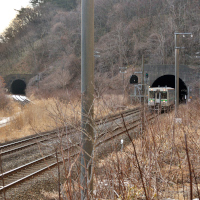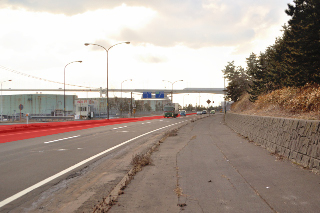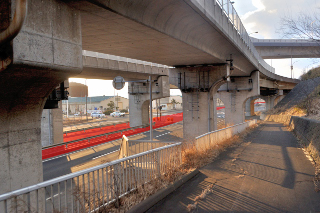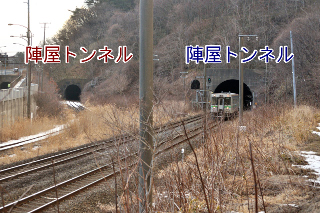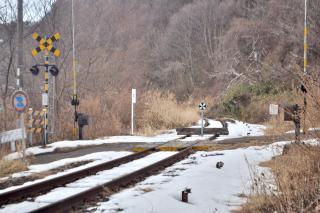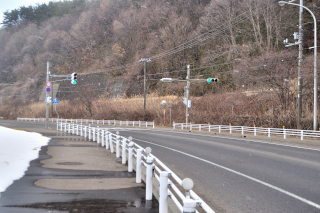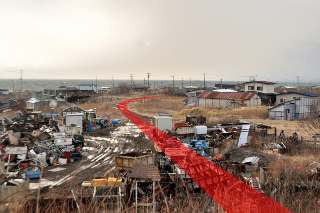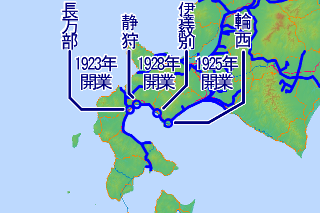
Muroran Main Line (室蘭本線, muroran honsen) started with the construction of the Muroran Line (室蘭線, muroran sen) that connecting Iwamizawa village (岩見沢村, iwamizawa mura) where gathers coal of Sorachi (空知, sorachi) area to Muroran district (室蘭郡, muroran gun) with shipping port by Hokutan (北炭, hokutan) At that time it was not “Hokkaido Coal Mine Steamship” but “Hokkaido Coal Mine Railroad”. on . Hokutan Muroran Line was nationalized on and renamed Muroran Main Line. Then the section that connecting Oshamambe Village (長万部村, oshamanbe mura) and Muroran City (室蘭市, muroran shi) added. At the time when this section didn’t exist, people had to rely on one Hakodate Line (函館線, hakodate sen) where Hakodate City (函館市, hakodate shi) – Sapporo City (札幌市, sapporo shi) had a lot of flexions steep slopes and heavy snow. Therefore, the idea of avoiding the rugged section, and linking comparatively flat Muroran Main Line to speed up was born. At , several sections were designated as the route that the government should build under the Hokkaido Railway Construction Law (北海道鉄道建設法, hokkaidō tetsudō kensetsu hō). There was no Muroran Main Line in it, but a railway connecting the Muroran Main Line and Hakodate Main Line (函館本線, hakodate honsen) will be added by tying Oshamambe Station (長万部駅, osyamanbe eki) and the Wanishi Station (輪西駅, wanishi eki) finally with the amendment of the law at . This line called the Osawa Line (長輪線, osawa sen) by taking initials of both is made up of Osawa West Line (長輪西線, osawa nishi sen) that connect Oshamambe Station and Shizukari Station (静狩駅, shizukari eki) opened at , and Osawa East Line (長輪東線, osawa higashi sen) that connect Wanishi Station (later the name changed to Higashi-wanishi Station (東輪西駅, higashi wanishi eki) → Higashi-Mmuroran Station (東室蘭駅, Higashi muroran eki)) – Date-monbetsu Station opened at . Finally, at , the section between Shizuokari Station and Date-monbetsu Station opened, Osawa Line was completed. With this, the general framework of Muroran Main Line is completed, and at April 1 1931, Osawa Line and Muroran Main Line were integrated and started as a new Muroran Main Line.
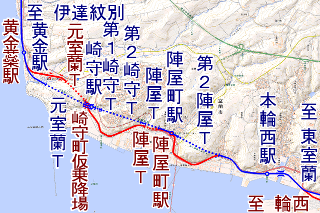
On the Osawa East Line which opened in , five station of Wanishi Station (present Higashi-muroran Station) – Motowanishi Station (本輪西駅, motowanishi eki) – Okonshibe Station (黄金蘂駅, okonshibe eki) (present Kogane Station (黄金駅, kogane eki)) – Mareppu Station(稀府駅, mareppu eki) – Date-monbetsu Station were put. Between them, I aggrandized between Motowanishi Station and Kogane station. The current line of this section is straightened with 5 tunnels. However, its old line, linear at the time of opening, weaves wastefully according to the unevenness of the topography.
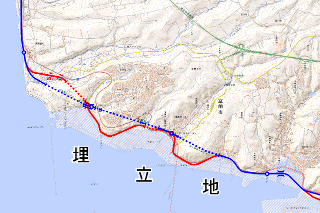
The reason is that the flatland along the coast is all landfill, and when this line was opened it was not yet landfilled and had to follow the topography. Except for tunnels with only 2, the old line shows the former coastline.
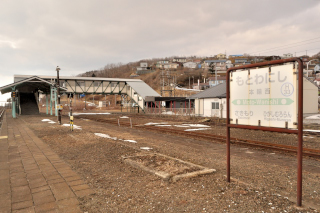
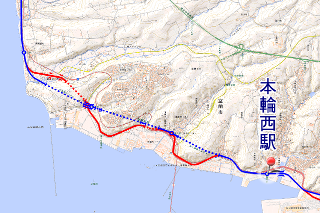
Tap! I came to Motowanishi Station on the eastern end of the map. Running in board is too pale! JR should better renew it soon.
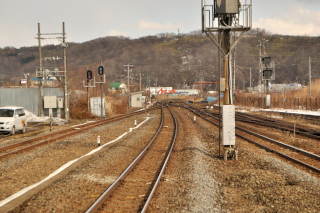

I’m watching the direction of Wanishi (Higashi-muroran) from the station. As for the Wanishi Station, change the name to Higashi-wanishi, Higashi-muroran as mentioned above, the position also moved, and my talk is going to be long, so I’m going to talk on another occasion. Motowanishi Station vicinity was landfill and almost not reclaimed at the time of opening. Namely trains ran on sea in opening. The embankment was heaped up in the sea, the range of this photo was only with one embankment among sea. At the end of the embankment there was Motowanishi Station. I heard at that time the station building located about 50m north.
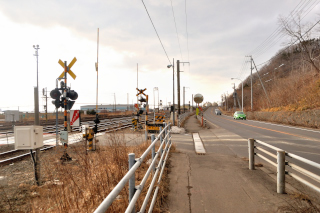

As soon as I walk towards Jinyamachi Station (陣屋町駅, jin’nyamachi eki) from Motowanishi Station I can see a level crossing. The name is “Kuribayashi Front level crossing (栗林前踏切, Kuribayashi mae humikiri)”. Kuribayashi’s house there is not. It means a company called Kuribayashi Company (栗林商会, kuribayashi shōkai). In fact, the founder of Kuribayashi Shokai Gosaku Kuribayashi (栗林五朔, kuribayashi gosaku) contributes to the construction of Osawa Line. There were two proposals when planning the route of Osawa Line, the current plan with the starting point as Oshamambe and the plan near Iburi Line as Kutchan. Mr. Kuribayashi was one of the leading drivers who chose the starting point of Oshamambe of them. In addition, he directly negotiated the Prime Minister Takashi Hara of the time to realize the early launch of Osawa East Line. Moreover, Mr. Kuribayashi built the foundation of the town by reclaiming Motowanishi which was just a cove is land. There are many other achievements, in railroad related, he also developed the Noboribetsu Spa (登別温泉, noboribetsu onsen) by laying down the Noboribetsu Spa Train (登別温泉軌道, noboribetsu onsen kidō).
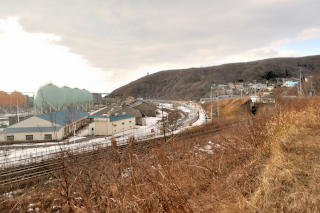
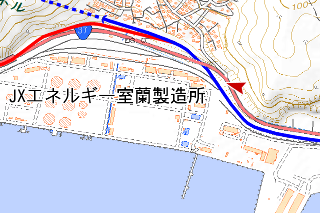
Next I can see exclusive line that loads petroleum products from JX Energy Muroran factory into a tank car. Until a few years ago it was a Muroran refinery so it was filled with many tank cars, but now it seems that it is not being used at all because it’s not producing oil.
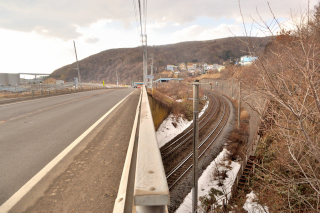
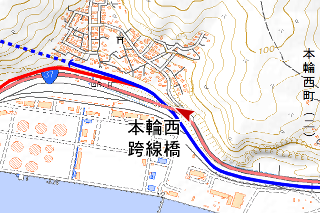
Muroran Main Line goes side by side with the exclusive line and after this goes through under the Motowanishi overpass independently and goes out to mountain side of the national road. This overpass was completed in , and before that it crossed flatly near Kuribayashi level crossing.

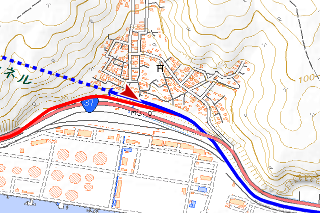
Then the old railroad accrue from here. The current line is double track, but the old line is single line. The trunk line shifted from Hakodate Main Line to Muroran Main Line by the completion of the Osawa Line and transportation volume increased, it gradually became double track since . In the process of making this double track, improved waves shape between the Kogane Station and Motowanishi Station straight.
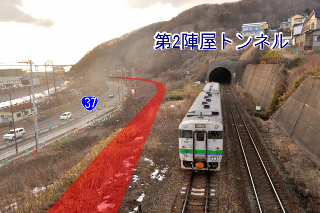
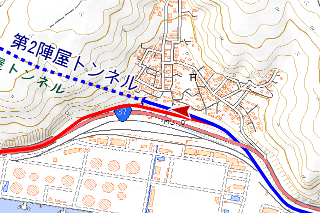
The current line enters the tunnel soon. The old line didn’t make a tunnel here and passed between the national road and the slope. The tunnel name of the current line is the No.2 Jinya tunnel (第2陣屋トンネル, daini jin’ya tonnel). Length 1,063m. By the way, although it is a double track non-electrification between the Oshamambe Station and Higashi-muroran Station, all tunnels of this section correspond to electrification. The section between Jinyamachi Station – Motowanishi Station that including No.2 Jinya Tunnel was completed at with double track. Meanwhile, the Kogane Station – Jinyamachi Station has been made double-track at early ten years .
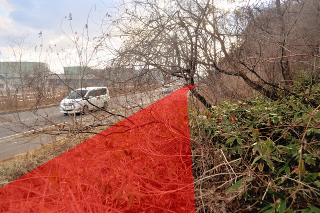
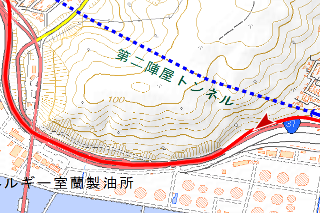
The old line was embankment and I tried walking over it, but it was interrupted quickly and swallowed by the national road.
I can’t imagine that the former line after became national road was railroad track.
In the vicinity of the Hakucho Bridge (白鳥大橋, hakuchō ōhashi) there are quite no signs of the railroad.

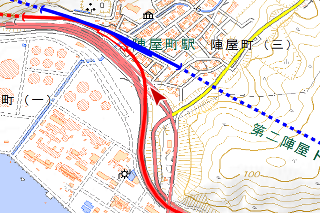
Even if Jinyammachi Station approaches, the trace had also gone. In fact, city of Jinyamachi hasn’t traces left because there was a improvement work of the land parcel at the same time as double track construction work.
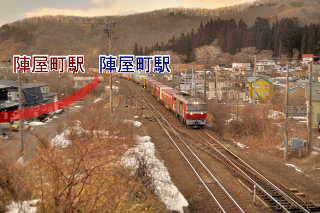
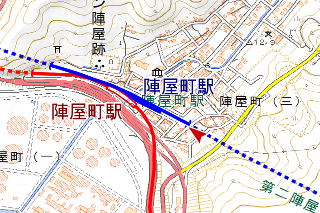
It’s Jinyamachi Station of the current line which locate after passed through No.2 Jinya tunnel. Before change it was neighbor the current station. Originally established as a signal station at , promoted to the station at . There is a sand beach in front of the station, it seems that used by sea bathers in the summer, but now it’s landfilled to untill over 500m ahead and lost value as a passenger station. And it became a freight exclusive station at August 1 1970.
From here, the old railroad is incorporated into Jinya-machi Station and I’ll abridge and write because it will same to yesterday for a while. In the vicinity of Jinyamachi Station, the current railroad and the old railroad contact and leave again. And a tunnel. Right one is current Jinya Tunnel (陣屋トンネル, jin’ya tonneru) 300 length. Left one is old Jinya Tunnel 841.50ft (≈256.49m) length.
Going through the old Jinya Tunnel, there is port No.1 level crossing (外港1号踏切, gaikō ichigō humikiri). Although it can not be seen from here, on the right, the current railroad passes through Jinya Tunnel and enters No.2 Sakimori Tunnel (第2崎守トンネル, daini sakimori tonneru).
The railroad ahead is parallel to the road. Until here it same with yesterday.
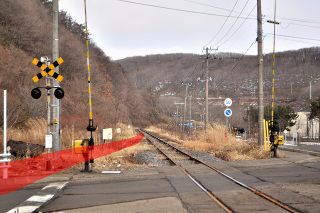
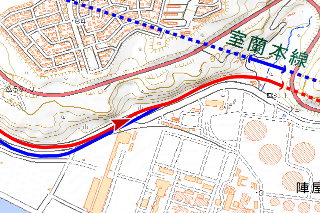
Before the former Old National Road Level Crossing yesterday passed, the old railroad divided as old railroad.
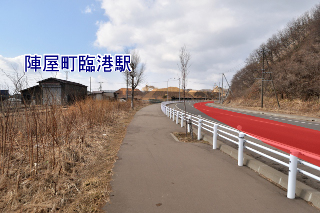
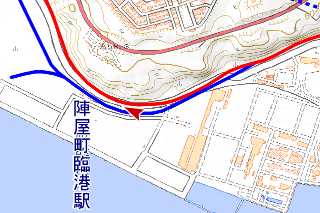
After this, I almost covered the road and proceed while watching Jinyamachirinko Station which I walked a lot on yesterday.
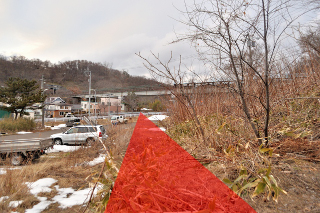

After this, I almost covered the road and proceed while watching Jinyamachirinko Station on the left which I walked a lot on yesterday.
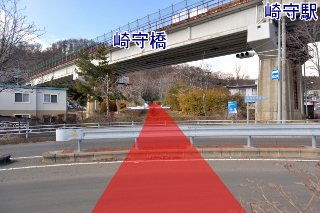
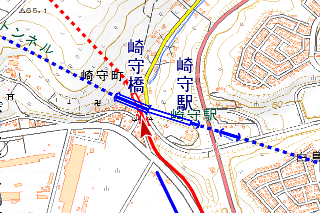
In past, the embankment still continued, crossing the road with overpass. But I can’t see the embankment at all. It’s Sakimori Bridge of the current railroad that I can see above. The current railroad and the old railroad are overpassing.
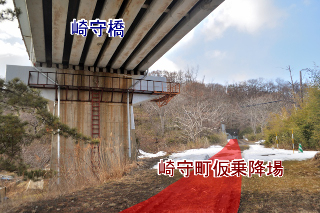
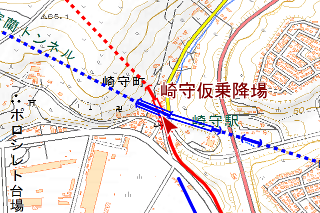
Under the crossover was Sakimoricho temporary Station located (崎守仮乗降場, sakimori kari jōkōjō). This temporary station was established on November 1 1955, switched to the present railroad and was abolished and Sakimori Station was newly established.
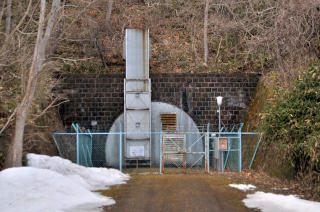
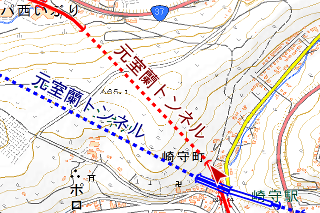
From the temporary station, slender vacant lot like a abolished line trace continues, and a tunnel is punched in the end. Motomuroran Tunnel (元室蘭トンネル, motomuroran tonneru) 2,174.30ft (≈662.73m). Current railroad is Motomuroran Tunnel. Old railroad is Motomuroran Tunnel too. Motomuroran from opening time. (“moto” means “past” in Japanese) It’s has moto probably because the place where place name “Muroran” originated. As seen in this tunnel, nothing is sealed or backfilled, but something like a secret base is made.
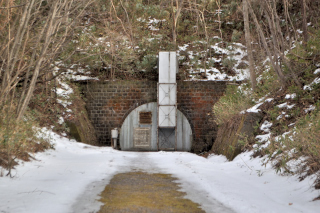
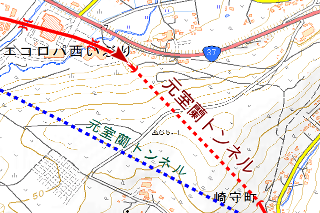
A mysterious facility on the other side too. Actually this is part of the pipeline that carries heavy oil from the Muroran oil send facility (室蘭送油所, muroran sōyu sho, it’s close to Old National Road Crossing) to Date power plant in Date City.
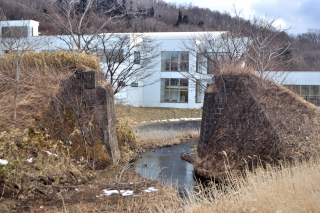
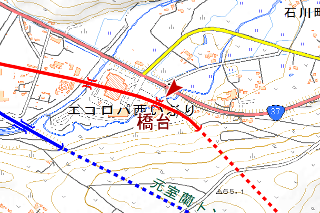
As I walk forward from front of the tunnel, there is an old abutment of bridge over the Petotoru River (ペトトル川, petotoru gawa). The embankment in front and behind was also broken down and only the abutment was remained.
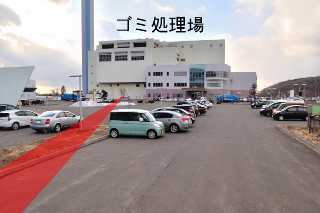
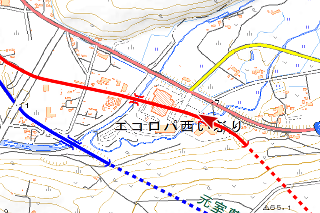
In the ahead Muroran City made a garbage disposal site in , everything of the railroad remains has gone.
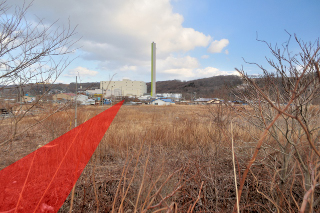
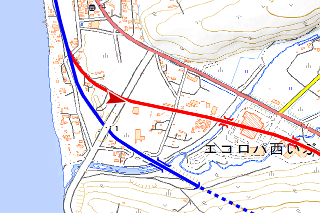
Once past the garbage disposal site there is nothing.
There is nothing if there is nothing to go no matter how much it goes.
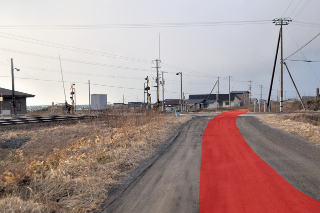
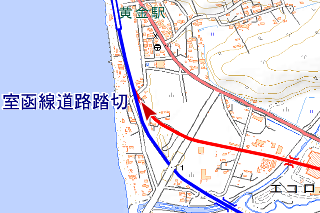
It finally joined the current railroad near the Muro-Hako Road Line Level Crossing (室函線道路踏切, murohako sen dōro humikiri) without anything.
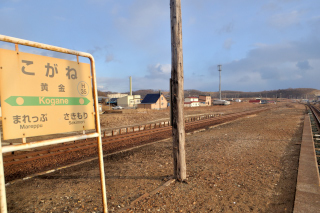
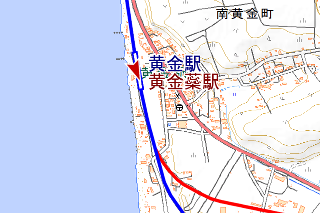
Arrived at the today’s end point, Kogane Station. At the time the station was opened, it was named “Okonshibe Station (黄金蘂駅, okonshibe eki) “, but kanji was too difficult, so name changed to “Kogane” at . Is “蘂” so difficult? Why does not Rubeshibe Station (留辺蘂駅, rubeshibe eki) change?
Infomation of this entry
Related entrys
Major points maps
References
- 『官報』
- 今尾恵介(監修)、『新潮旅ムック 日本鉄道旅行地図帳1号北海道 全線・全駅・全廃線』、新潮社、2008年
- 太田篤司「室蘭本線(本輪西~黄金間)の変遷」、『茂呂欄 室蘭地方史研究』43号(2009年)、pp.66-70
- 栗林100年史編集委員会(編纂)、『栗林100年史』、株式会社 栗林商会、1996年
- 札幌鉄道管理局営業部旅客課長 池田晴男(編輯)、『北海道 駅名の起源』、日本国有鉄道、1929年
- 日本国有鉄道札幌工事局70年史編集委員会(編集)、『札幌工事局70年史』、日本国有鉄道札幌工事局、1977年
- 日本国有鉄道北海道総局、『北海道鉄道百年史 下巻』、日本国有鉄道北海道総局、1981年
